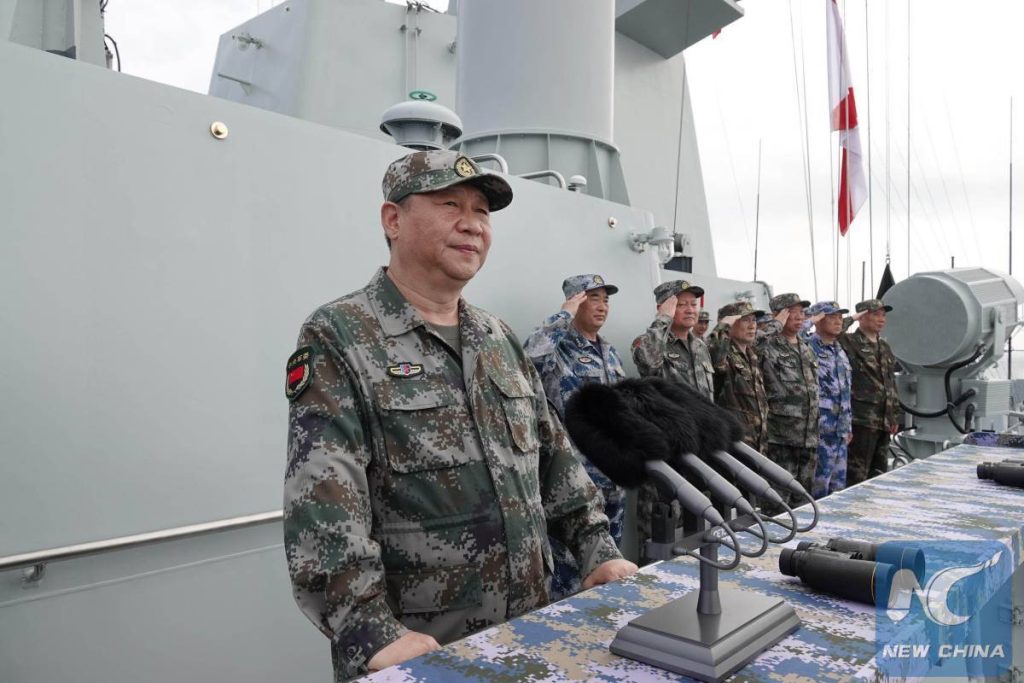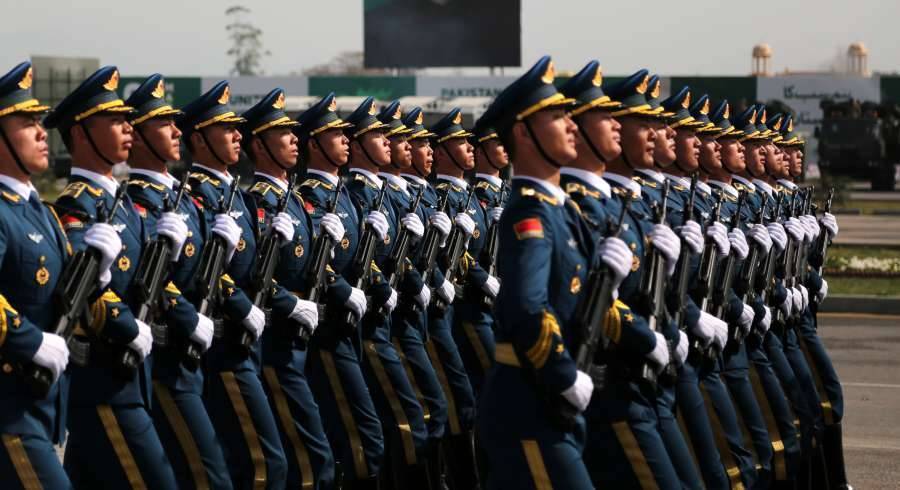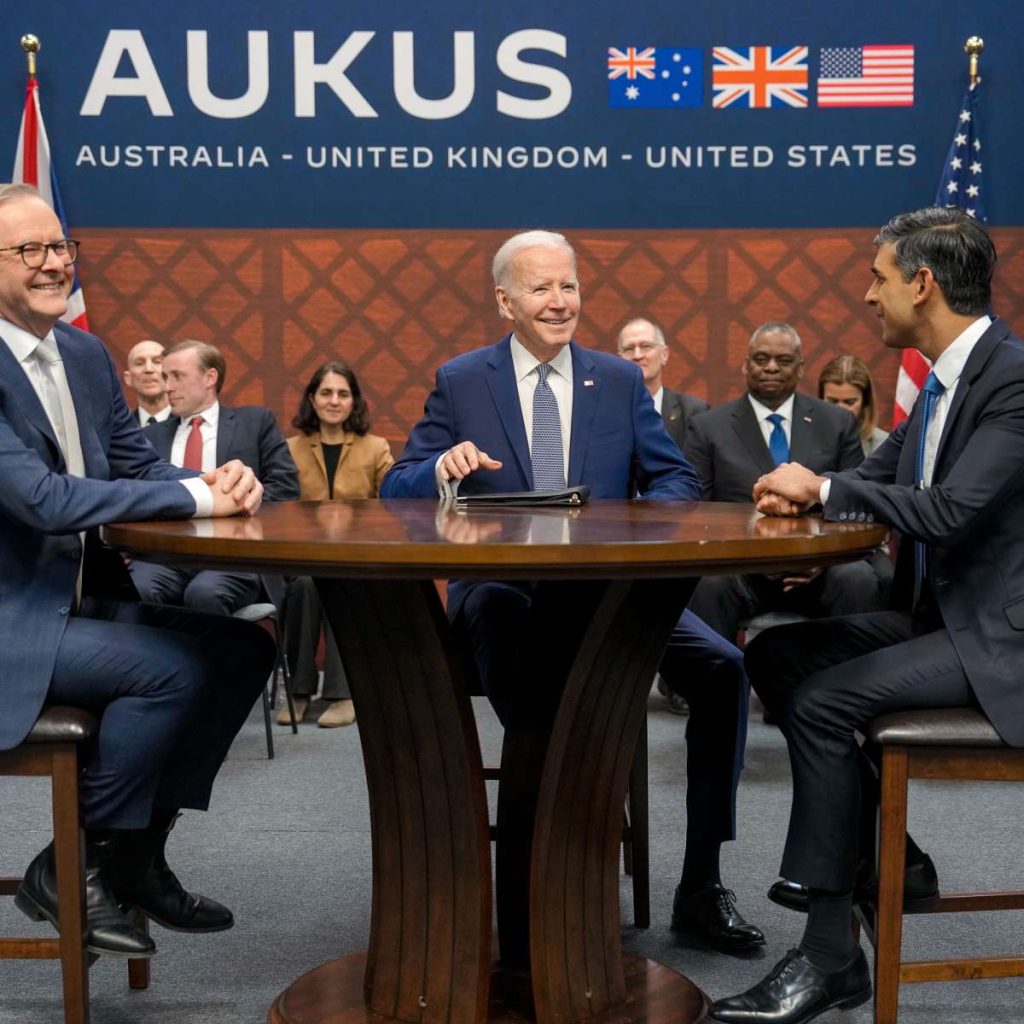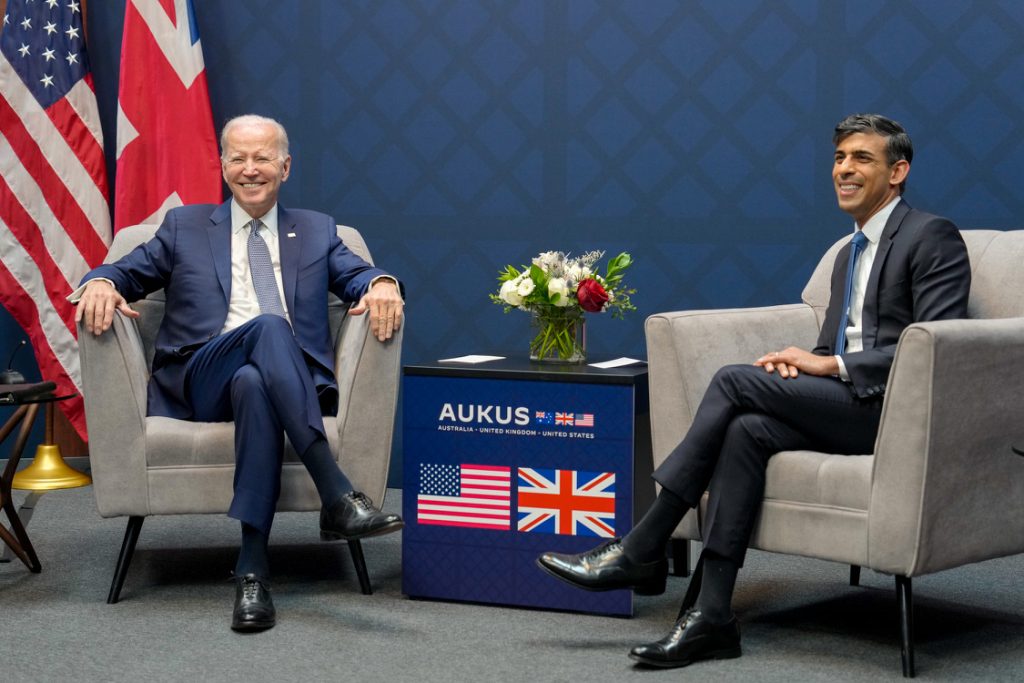The Australian, British and American national leaders said the AUKUS deal demonstrated a shared commitment to a “free and open Indo-Pacific region”, one where the PLA Navy (PLAN) is increasingly throwing its weight around as it modernizes at a staggering rate….reports Asian Lite News
China reacted furiously to a March 13 announcement by the three AUKUS partners of Australia, the UK and US about Canberra’s pursuit of nuclear-powered attack submarines. Yet its arguments are largely hypocritical and lame.
Beijing is lambasting AUKUS for proliferating nuclear technology – in this case nuclear propulsion, which has nothing whatsoever to do with weapons – whereas Chairman Xi Jinping kept silent when President Vladimir Putin threatened nuclear escalation in Ukraine after his failed offensive to subdue Kyiv, or benevolently winks at Kim Jong-un’s nuclear antics in North Korea. Australia will initially buy three Virginia-class nuclear-powered attack submarines (known by the common naval acronym SSN) from the USA. These are likely to be second-hand boats from the US Navy (USN), plus there is an option for obtaining two more Virginia-class submarines should plans to build a new class of SSN-AUKUS boats be delayed.
The SSN-AUKUS submarine will be largely based on a British SSN design, but with the incorporation of some American technology. Both the UK and Australia will obtain SSN-AUKUS boats, with British production kicking off slightly earlier than in Australia, which is a total novice at such sophisticated shipbuilding. The whole intent is for Canberra to be able to build and maintain a fleet of SSNs as a sovereign capability, but with support from the UK and USA.
Australia will become the seventh country in the world to operate nuclear-powered submarines. Of course, it should be pointed out once again that these Australian SSNs are not capable of carrying ballistic missiles armed with nuclear warheads. They are not ballistic missile submarines (SSBN), which only a very exclusive club of nations operate.

Part of the optimal pathway for Australia to gain SSN experience is for the USN to increase its SSN port visits to Australia beginning this year, and the Royal Navy from 2026. Then, in 2027, Submarine Rotational Force – West will be created, comprising one British Astute-class and up to four American Virginia-class SSNs that will operate from HMAS Stirling, a naval base in Western Australia.
Eventually, Australia will also establish a nuclear submarine base on its eastern seaboard. This part of the agreement is hugely important, as it gives the USA in particular a new submarine base in the Indo-Pacific besides the existing ones of Guam and Hawaii. This greatly complicates China’s calculus in trying to detect and track American submarines, for they can arrive from a completely different direction than the Western Pacific.
The Australian, British and American national leaders said the AUKUS deal demonstrated a shared commitment to a “free and open Indo-Pacific region”, one where the PLA Navy (PLAN) is increasingly throwing its weight around as it modernizes at a staggering rate.
The Office of Naval Intelligence in the USA expects China’s submarine fleet to grow from around 66 boats today to 76 by 2030. The PLAN could have up to eight SSBNs by 2030, plus it is snowballing its total inventory of nuclear warheads. The Pentagon estimates the PLA will have up to 700 deliverable nuclear warheads by 2027, and 1,000 just three years after that.
For some inexplicable reason, China believes it should be allowed as many SSNs, SSBNs and land-based nuclear-tipped ballistic missiles as it wants, but that Australia should not adopt nuclear propulsion. This is sheer hypocrisy, especially given the secrecy and obfuscation that China engages in regarding its nuclear forces. It has not offered any explanation, and has
issued only denials, about several enormous fields of missile silos for intercontinental ballistic missiles that it has been building over the past few years.
Indeed, China’s disingenuous propaganda is attempting to muddy the waters as it roundly criticizes Canberra, London and Washington DC. Chief among the arguments is Beijing’s deliberate blurring between nuclear propulsion and nuclear weapons. They are completely different things, but China will not stop shaking this bone.

China also makes much of weapons-grade highly enriched uranium being transferred to Australia, but this is misleading. The nuclear reactors for the SSN-AUKUS submarines will be transferred to Australia as complete, sealed units. No nuclear materials can be diverted into nuclear weapons, plus all three AUKUS partners have categorically denied any interest in nuclear weapons for this deal.
Another important prong to China’s criticisms of AUKUS is “grave concerns over nuclear proliferation”. Beijing claims blatant violations of the 1968 Nuclear Non-Proliferation Treaty (NPT) and the 1986 Rarotonga Treaty. As an example, China’s mission to the United Nations tweeted that the deal “constitutes serious nuclear proliferation risks, undermines the international non-proliferation system, fuels an arms race, and hurts peace and stability”.
Chinese academics misleadingly allege that AUKUS “is essentially equivalent to directly arming a non-nuclear country with nuclear weapons”. This is sheer guile and misdirection. Australia has signed up to both the NPT and Rarotonga Treaty. However, an examination of both treaties quickly silences Chinese complaints.
Crucially, the NPT only applies to nuclear materials associated with nuclear weapons. Indeed, Article 4 has a carve-out covering nuclear materials for “peaceful purposes”, which ironically
enough covers nuclear propulsion since it encompasses anything except nuclear weapons. The NPT also discusses processes whereby the International Atomic Energy Agency (IAEA) monitors nuclear programs and materials even if used for peaceful purposes.
Australia has existing subsidiary arrangements with the IAEA discussing how such safeguard arrangements would work. For example, Article 14 says “non-proscribed military purposes” are permitted. Australia thus fully complies with the NPT, and has fully undertaken to comply with safeguard obligations with the IAEA.
Nuclear fission materials are exempted from IAEA monitoring if they are used for non-explosive military use. China calls this transfer of material from a nuclear weapon state to a non-weapons state as a “loophole” and “setting a bad precedent”, but Australia is completely following the rules to which China itself adheres.
Nonetheless, China continues to bang on about nuclear proliferation, even while Beijing winks at dangerous regimes like Iran and North Korea developing nuclear weapons. This is where the true double standards and hypocrisy lie. The aforementioned Rarotonga Treaty, also known as the South Pacific Nuclear Free Zone Treaty, supports the NPT. Signatories agree to maintain a nuclear weapon-free zone in the South Pacific, but it certainly does not prevent members from using nuclear propulsion. Again, China’s reference to these two treaties is pointless, for

AUKUS does not violate them in any way.
As Lauren Sanders, Senior Research Fellow on Law and the Future of War at the University of Queensland, stated: “On the face of the announcements made so far, the deal complies with international law, despite accusations to the contrary from China and other critics.”
Another argument that China raises is that AUKUS perpetuates a “Cold War mentality”. Chinese Foreign Ministry spokesman Wang Wenbin said, “This is a typical Cold War mentality, which will only stimulate an arms race, undermine the international nuclear non-proliferation system, and damage regional peace and stability.”
Yet China is the one rapidly multiplying its nuclear forces, while Australia has clearly stated it will not obtain nuclear weapons. Nobody has damaged regional peace and stability as much as China with the PLA deliberately bludgeoning and coercing neighbors with military strength, and actively threatening war on Taiwan.
An opinion piece published on a website affiliated with the PLA said “AUKUS” countries should drop their double standard and respond to the international community’s concerns. They should fulfil their non-proliferation obligations and maintain candid and transparent communication with other countries on the basis of equality and mutual respect under the framework of the International Atomic Energy Agency.”
Such finger pointing should be reflected straight back at China. Beijing should respond to regional and international concerns, should transparently communicate why it is expanding its nuclear weapons arsenal, and treat others with mutual respect. Blame should also be assigned to China for proliferating nuclear weapons. A 1983 National Intelligence Estimate in the USA said China, during the 1980s and 1990s, transferred nuclear and missile technology to other countries’ weapons programs.
“China provided assistance to Pakistan’s nuclear weapons program and engaged in nuclear cooperation with Iran. Beijing exported missiles to Pakistan, Saudi Arabia and Iran.” Even as recently as 2019, a US State Department report commented, “Chinese entities” continued in 2018 “to supply Missile Technology Control Regime-controlled items to missile programs of proliferation concern, including those in Iran, North Korea, Syria and Pakistan.”
As part of its smear campaign, China is also dragging out the old tropes that Australia thinks it is the USA’s “deputy sheriff” in the Asia-Pacific region. Another opinion piece concluded “Australia’s inexplicable sense of insecurity when facing China is basically the result of being spiritually controlled for many years by the US.” When all else fails, China simply throws mud at opponents in the hope that some might stick.
Wang, the Foreign Ministry spokesman, said “they completely disregard the international community’s concerns and are walking further on the dangerous and wrong path for the sake of their selfish geopolitical interests”. This is perhaps the closest Beijing comes to raising a relevant point.
Australia is pursuing a policy of being able to militarily strike at opponents well beyond its own
shores. However, Canberra has said little about how this might impinge upon neighbors, plus the secrecy surrounding AUKUS has put regional countries like Indonesia on the back foot.

Apart from vitriol, how else will China react? One serious concern is that Beijing will use this AUKUS plan as a pretext to accelerate expansion of its own SSN and SSBN fleets.
Let it be noted that this would be a pretext. China has already been progressively improving its submarine platforms, even though qualitatively it still trails the USA. China has also expanded its nuclear submarine-building facilities at Huludao in Liaoning Province, so the time is already ripe for it to expand production. AUKUS would therefore make a convenient scapegoat for what China has already predetermined will happen.
If Xi does take China on such a trajectory, this will gravely alarm the USA. Indeed, China’s actions may spark a greater arms race, as the USA sees the need to keep pace with the PLAN. Wang said, without a trace of irony: “China is always committed to maintaining the international order which has the United Nations at its core and is based on international laws, upholding genuine multilateralism, promoting a multipolar world and the democratization of international relations, and pushing global governance in a more just and reasonable direction.”
Such sentiments are laughable, as are Xi’s similar comments prior to a visit to see his friend Vladimir Putin in Moscow. China and Russia have no interest in international law, democratization and just global governance. These authoritarian regimes are all about sustaining their power and bending others to their wills. There must be considered a possibility, then, that AUKUS might push China closer into a bilateral partnership with Russia. It is not impossible that the two partners might create their own “anti-AUKUS” axis involving undersea technology and platforms.
Russia still possesses better submarine technology than China, so it might be prepared to horse trade it for other forms of Chinese military or industrial aid that it needs to sustain war in Ukraine. Might Iran even be invited into the fold to create a true trilateral axis? Iran has been willingly supplying loitering munitions and drones to Russia for use against Ukraine. Such a Sino-Russian deal would complicate the situation for the USA and the West.
Chaos stemming from submarine technological knowhow sharing could spread from Russia to the Indo-Pacific to the Middle East. The proliferation of far more effective Chinese nuclear-powered submarines would vastly complicate matters for the USN. But what does China have to lose? Its relations with the USA are already at a low ebb, and it is furious about AUKUS. On the other hand, Xi continues to profess undying love for Putin and Russia, and it would be no surprise if AUKUS is a topic of discussion between the two dictators. (ANI)














